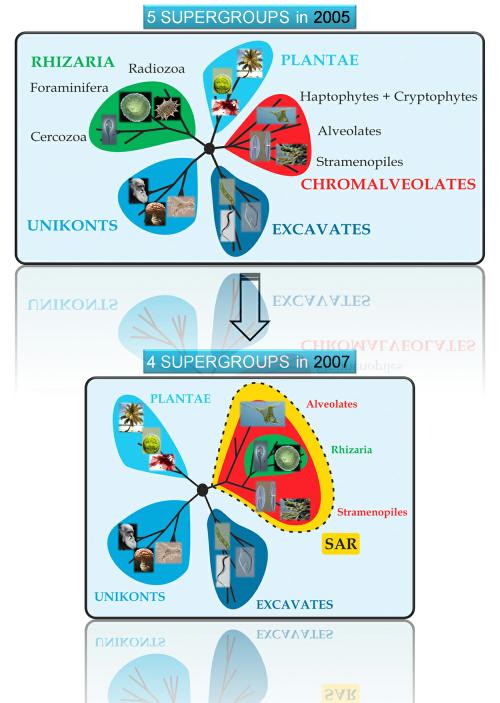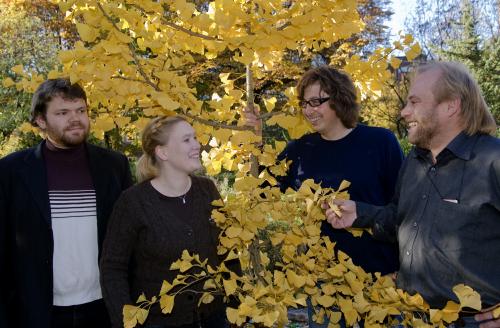The Tree of Life has lost one of its branches due to the discovery that two formerly separated branches share a similar evolutionary history.
It's more than just re-drawing textbooks.
The discovery by Norwegian and Swiss researchers has gained attention from biologists worldwide. The findings come from the largest ever genetic comparison of higher life forms on the planet. Of 5000 genes examined, researchers identified 123 common genes from all known groups of organisms; these common genes have been studied more closely. The study has required long hours of work from the researchers and an enormous amount of computing resources—supplied through a large network of computers at the University of Oslo.
“The results were pretty astounding. All non-bacterial life on Earth—called eukaryotic life— can now be divided into four main groups instead of the five groups that we have been working with up to now,” says Kamran Shalchian-Tabrizi, an associate professor from the University of Oslo’s Department of Biology who has also worked with the Department of Zoology and Animal Biology and the Department of Genetic Medicine and Development, at the University of Geneva, Switzerland.

The research group has found that brown algae and silica algae, and groups of single cell organisms like the malaria parasite, marine foraminifera, and the green sun animalcule (acanthocystis turfacea) actually belong to the same group. Previously, these species were thought to be completely unrelated.
“Kinship says a lot about shared traits. Our findings can be important in many fields, such as in the study of the development of life and in the manufacture of new medicines” says Shalchian-Tabrizi in an interview with the University of Oslo’s research magazine Apollon.
“Our knowledge of organisms and the development of medicines are often based on comparative studies across species. It is, therefore, essential that we know the relationships between the largest groups in the great diversity of eukaryotes,” he adds.
The New Branch
All life on Earth can be divided into two essentially different life forms—eukaryotes and prokaryotes. The eukaryotes gather their genetic material in a nucleus, while the prokaryotes (bacteria and archaea) have their genetic material floating freely in the cell. Eukaryotic organisms—such as humans—can, as a result of the new findings, be divided into the following four categories:
- Plants (green and red algae, and plants)
- Opisthokonts (amoebas, fungi, and all animals—including humans)
- Excavates (free-living organisms and parasites)
- SAR (the new main group, an abbreviation of Stramenophiles, Alveolates, and Rhizaria, the names of some of its members)
“The SAR group has to some extent been identified earlier, but we could not know if it was a correct observation because we lacked statistical data. To get that data, we first had to reconstruct the entire eukaryote tree with the help of these 123 genes. Chromalveolates and rhizaria were clearly separate groups until we published our results,” says Shalchian-Tabrizi.
“To make the picture a little less clear, one branch of chromalveolates is still in no man’s land. It may be that these also belong to SAR, but we will require additional genes and genomes to study this. We have set our sights on doing that in the course of the next few years,” he adds.

“The Tree of Life tells the story of life on Earth, and our research can say something about how quickly life developed. Our discovery suggests that there were fewer big “events” than we have previously assumed in the development of higher life forms. The more we know about the branches on the Tree of Life, the more we can find out about life’s Big Bang, the beginning of life on Earth,” says Shalchian-Tabrizi.
Three billion years ago, there was only bacteria and Archaea. Eukaryotic life, which comprises all multi-celled organisms, developed in the sea—probably between 1.2 and 1.6 billion years ago. It was not before about 500 million years ago that the first creatures crept onto land.
“By digging down into the historical layers with the help of phylogenetic reconstruction, where we can find out about kinship between organisms at the genetic level and we can find answers to questions about how new traits developed. We are working, in a matter of speaking, with genetic archaeology. In this manner, we can also discover the cause of the Earth’s biological diversity,” says Jakobsen.
Burki F, Shalchian-Tabrizi K, Minge M, Skjæveland Å, Nikolaev SI, et al. (2007) Phylogenomics Reshuffles the Eukaryotic Supergroups. PLoS ONE 2(8): e790. doi:10.1371/journal.pone.0000790





Comments